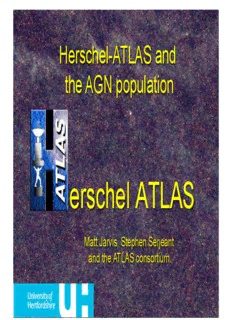
Herschel-ATLAS and the AGN population PDF
Preview Herschel-ATLAS and the AGN population
Herschel-ATLAS and the AGN population erschel ATLAS Matt Jarvis, Stephen Serjean t and the ATLAS consortium NGP and Equatorial SGP SD field Fields chosen to allow maximum overlap with existing and planned surveys GALEX, 2dF, SDSS, GAMA, UKIDSS, KIDS, VIKING, PanSTARRS, DES, SPT, SASSy and to be accessible to new facilities which will be valuable for follow-up ALMA, ASKAP, MeerKAT, SCUBA2, LOFAR, e-MERLIN Key Science Themes in ATLAS 1. Local Universe Survey 2. Synergies with Planck 3. The Herschel Lens Survey 4. AGN and rare objects 5. Large scale structure and High-z galaxies 6. Galactic star and planet formation Key Science Themes in ATLAS 1. Local Universe Survey 2. Synergies with Planck 3. The Herschel Lens Survey 4. AGN and rare objects 5. Large scale structure and High-z galaxies 6. Galactic star and planet formation AGN and galaxy formation • AGN are now key ingredients in the latest semi- analytic models • Aid in truncating star formation • However, observational evidence is relatively weak and hindered by a multitude of selection effects • Herschel-ATLAS is ideally placed to trace the impact of AGN activity on galaxy formation With H-ATLAS we have sufficient area to explore AGN properties as a function of redshift, luminosity, accretion rate, radio- loudness, etc etc Bonfield et al. The Lilly-Madau plot for QSO host galaxies With H-ATLAS we have sufficient area and AGN samples to explore AGN properties as a function of redshift and Serjeant et al. 2010 luminosity/ (special issue) accretion rate. The Lilly-Madau plot for QSO host galaxies Serjeant et al. A&A, -22>I >-24 special isssue AB Evidence for -24>I >-26 AB downsizing in the QSO host galaxies -26>I >-28 AB Luminous QSOs have higher SFR at higher z -28>I >-30 AB The dependence of far- infrared luminosity on QSO luminosity and redshift Bonfield et al. in prep. BPT diagram for AGN in the SD field using SDSS spectra Trichas et al. in prep.
Description: